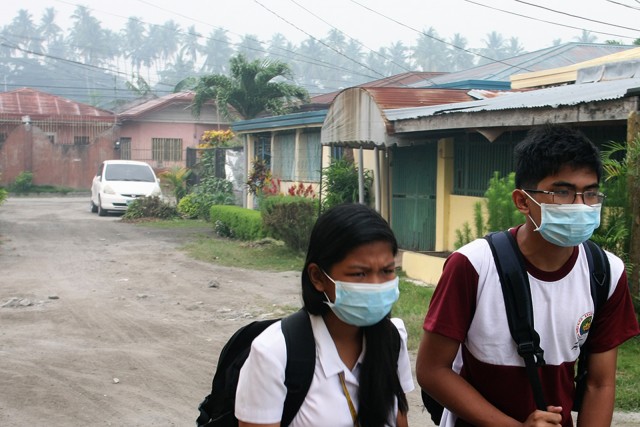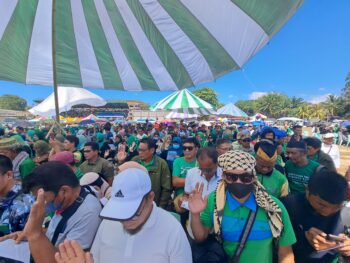GENERAL SANTOS CITY (MindaNews/23 October) — With the area’s air quality still at “safe levels,” the Department of Health (DOH) in Region 12 allayed fears on Friday of serious health hazards as a result of exposure to the thick haze that has been hovering over this city and neighboring areas.
Dr. Teogenes Baluma, DOH Region 12 director, said air quality assessments showed that the particulates present in the air in this city and other parts of the region remained at tolerable levels and were not expected to directly cause health problems to residents.
He said such assessment was based on the air quality monitoring conducted by the Department of Environment and Natural Resources’ Environmental Management Bureau in Region 12.
 Some residents of General Santos City have been wearing masks as a precaution against the haze that blankets the area and other parts of Mindanao, as shown in this photo taken on 23 October 2015. MindaNews photo by Rommel Rebollido
Some residents of General Santos City have been wearing masks as a precaution against the haze that blankets the area and other parts of Mindanao, as shown in this photo taken on 23 October 2015. MindaNews photo by Rommel Rebollido
EMB-12 has been closely monitoring the air quality here and nearby Koronadal City due to the emergence of the haze, which reportedly originated from forest fires in Sumatra, Indonesia.
The agency has existing ambient air monitoring systems at the Acharon Sports Complex here and at the city hall complex in Koronadal City.
“As of now, there’s nothing to be alarmed as of now as our situation is still tolerable when it comes to health concerns,” Baluma said in a press conference.
But he advised residents who are sensitive to particulates in the air and have lingering respiratory diseases to take extra precaution and avoid direct exposure to the thick haze.
He said the frequent exposure to the haze could trigger or aggravate asthma and other respiratory infections.
“It’s better for individuals who are suffering from respiratory illnesses to always wear face masks and other protective gears,” he said.
Health personnel here have reported rising cases of respiratory tract infections among local residents since the haze was first monitored two weeks ago.
On Thursday, two residents here were reported to have died from acute asthma attacks that were supposedly triggered by exposure to the haze.
Baluma said they are still verifying the matter but raised doubts whether they were really caused by the haze.
As of Thursday, the EMB-12 said the fine particulate matters with a diameter of 2.5 micrometres or PM2.5 present in the air in this city remained below the standard 75 micrograms per normal cubic meter (ug/Ncu.m).
PM2.5 refers to pollutants that are “thinner than hair strands and smaller than sand grains” that could pose adverse effects to human health when breathed.
Ma. Socorro Lanto, EMB Region 12 director, said they monitored the PM2.5 level here at 59.86 ug/Ncu.m, which increased from 50.50 ug/Ncu.m on Wednesday.
But in Koronadal City, she said the PM2.5 level already exceeded the standard rate at 83.3 as of Thursday.
The area posted an average PM2.5 rate of 62.96 ug/Ncu.m on Wednesday.
Lanto said their monitoring results showed an increasing trend in particulate matters in the air since Oct. 17.
“As of now, this is not yet a health concern although it could be a problem for our airport operations,” she said.
Last Saturday, several flights at the city airport were cancelled due to poor runway visibility as a result of the thick haze.
The Air Traffic Control Office here confirmed that some flights from Manila to this city were diverted to Davao City due to the haze. (MindaNews)
